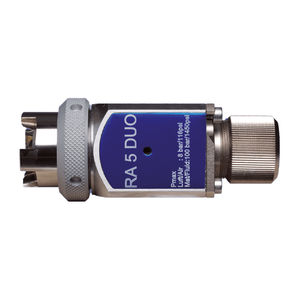
- Products
- Catalogs
- News & Trends
- Exhibitions
Spraying gun KAA 1300paintautomaticlow-pressure


Add to favorites
Compare this product
Characteristics
- Function
- spraying
- Product
- paint
- Operational mode
- automatic
- Other characteristics
- low-pressure, airless
- Pressure
50 bar
(725.19 psi)
Description
The automatic spray gun KAA 1300 is designed for automatic (not manual) coating of surfaces such as metal, plastic, ceramics, wood and similar materials as well as other substrates
Typical coating materials include paints, dyes, water-soluble paints, adhesives, oils, release agents etc. The KAA 1300 gun can also be used to process abrasive coating materials at operating pressures below 5 MPa (50 bar). The spray gun works on the ?airless? principle ? in other words, the spray jet is generated solely by the material pressure that ejects the material through a nozzle. After exiting the nozzle, the spray jet takes on the shape dictated by the nozzle. The jet is directed at the workpiece, and the effective spray fan is not quite as wide as theoretically possible.
The particles of the spray jet reach far higher speeds than with spray guns driven by compressed air. Accordingly, the material throughput is higher and the jet more focused (in other words, the swirling zone is smaller). The size and shape of the jet can only be altered by changing the nozzle. The diameter of the nozzle bore determines the material flow volume, while the size and geometry of the always elliptically shaped nozzle opening determine the height and width of the jet (shape of an elliptical cone). A wide range of airless nozzles are available.
The nozzle can be rotated steplessly by 360° in the axis of the spray jet and arrested in any position. This permits optimum adjustment of the angle at which the jet hits the workpiece to the prevailing conditions.
Catalogs
gamme de produit
46 Pages
*Prices are pre-tax. They exclude delivery charges and customs duties and do not include additional charges for installation or activation options. Prices are indicative only and may vary by country, with changes to the cost of raw materials and exchange rates.













